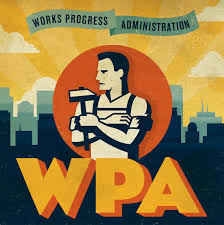Works Progress Administration: Difference between revisions
No edit summary |
No edit summary |
||
| (2 intermediate revisions by 2 users not shown) | |||
| Line 1: | Line 1: | ||
[[File:WPA.jpeg|right|225px]] | |||
The '''Works Progress Administration''' ('''WPA''') was a federal work relief program operated as part of the "New Deal" program to combat unemployment during the [[Great Depression]]. The program operated in [[Birmingham]] from September [[1937]] to May [[1943]] and employed as many as 9,000 people locally during its peak. It's offices were located in the [[Southern Club]] building at 500-508 [[20th Street North]]. | The '''Works Progress Administration''' ('''WPA''') was a federal work relief program operated as part of the "New Deal" program to combat unemployment during the [[Great Depression]]. The program operated in [[Birmingham]] from September [[1937]] to May [[1943]] and employed as many as 9,000 people locally during its peak. It's offices were located in the [[Southern Club]] building at 500-508 [[20th Street North]]. | ||
| Line 7: | Line 8: | ||
In addition to construction projects, the Works Progress Administration included a [[Federal Art Project]]. Alabama's WPA art programs were overseen by [[Richard Blauvelt Coe]]. | In addition to construction projects, the Works Progress Administration included a [[Federal Art Project]]. Alabama's WPA art programs were overseen by [[Richard Blauvelt Coe]]. | ||
Beyond marshaling labor, the WPA also provided financing for construction projects, including the 16-story [[Jefferson | Beyond marshaling labor, the WPA also provided financing for construction projects, including the 16-story [[Jefferson Towers|Jefferson Hospital]] and the [[Graymont Armory]]. | ||
==Projects in the Birmingham District== | ==Projects in the Birmingham District== | ||
| Line 18: | Line 19: | ||
* Classrooms at [[Glen Iris Elementary School]] | * Classrooms at [[Glen Iris Elementary School]] | ||
* [[Hillman Hospital Outpatient Clinic]] | * [[Hillman Hospital Outpatient Clinic]] | ||
* Football stadium at [[Hueytown High School]] | * [[Gilmore-Vines Stadium|Football stadium]] at [[Hueytown High School]] | ||
* Gymnasium at [[Mortimer Jordan High School]] | * Gymnasium at [[Mortimer Jordan High School]] | ||
* [[Allan Gray Fish Hatcheries]] and [[Lane Park Arboretum]] at [[Lane Park]] | * [[Allan Gray Fish Hatcheries]] and [[Lane Park Arboretum]] at [[Lane Park]] | ||
Latest revision as of 16:16, 11 January 2021
The Works Progress Administration (WPA) was a federal work relief program operated as part of the "New Deal" program to combat unemployment during the Great Depression. The program operated in Birmingham from September 1937 to May 1943 and employed as many as 9,000 people locally during its peak. It's offices were located in the Southern Club building at 500-508 20th Street North.
The Birmingham program was overseen by Birmingham's Commissioner of Public Improvements Jimmy Morgan with technical assistance from the Birmingham Department of Engineering and additional consultation with the Jefferson County Department of Health.
In April 1943 Morgan calculated the total value of the work done by the WPA under his supervision at $4,169,572.56 (more than $63 million in 2019 dollars). Most of the cost for the work was provided by the United States, with a small percentage of city funding which was offset by savings in maintenance costs and damage claims. Additional federally-funded projects, some with labor provided through the WPA, were carried out by the Housing Authority of the Birmingham District and the Federal Bureau of Roads.
In addition to construction projects, the Works Progress Administration included a Federal Art Project. Alabama's WPA art programs were overseen by Richard Blauvelt Coe.
Beyond marshaling labor, the WPA also provided financing for construction projects, including the 16-story Jefferson Hospital and the Graymont Armory.
Projects in the Birmingham District
- Alabama Highway 174
- Bessemer City Hall
- numerous projects in Carbon Hill
- Fairfield City Hall
- Outdoor classroom at Graymont Elementary School
- Green Springs Villa at Green Springs Park (George Ward Park)
- Classrooms at Glen Iris Elementary School
- Hillman Hospital Outpatient Clinic
- Football stadium at Hueytown High School
- Gymnasium at Mortimer Jordan High School
- Allan Gray Fish Hatcheries and Lane Park Arboretum at Lane Park
- Improvements to Legion Field
- Auditorium and library for Leeds High School
- Locust Fork High School
- McAdory High School
- Addition to McElwain Elementary School
- Completion of Municipal Auditorium (Boutwell Auditorium)
- Improvements to Oak Hill Cemetery
- Lake Tranquility dam at Oak Mountain State Park
- Slossfield Community Center and Slossfield Library
- Renovation of Woodrow Wilson Park (Linn Park)
- Improvements to Phelan Park
- Rosedale High School
- Vulcan Park construction
- Wilton pump house and reservoir
- 45 miles of streets graded
- 88 miles of streets paved
- 46 miles of sidewalks poured
- 70 miles of curb and gutter installed
- 22 miles of sanitary sewers laid
- 24 miles of storm sewers constructed
- 15 miles of stream bank erosion control
- Construction of drainage culverts throughout the city
- Replacement of 525 small wooden bridges throughout the city
- Flood mitigation work on Village Creek
- Elimination of 3,742 "dry toilets" and septic tanks
Art projects
- Brother Bryan statue for Five Points Circle
- "Early Settlers Weighing Cotton" mural at Montevallo Post Office
- "Youth's Strife in the Approach to Life's Problems" mural at Woodlawn High School
- "Historical Panorama of Alabama Agriculture" murals for the 1939 Alabama State Fair
- "Scenes of Discovery" mural for the Lakeview School
- "Spirit of Steel" mural for the Fairfield Post Office
- "From Oxcart to Airplane" pageant at Legion Field
See also
References
- "WPA Improvements Program In City Totals $4,169,572" (April 18, 1943) Birmingham Age-Herald - via Birmingham Public Library Digital Collections
- Birmingham Historical Society (2010) Digging Out of the Great Depression: Federal Programs at Work in and around Birmingham. Birmingham: Birmingham Historical Society ISBN 0943994357
